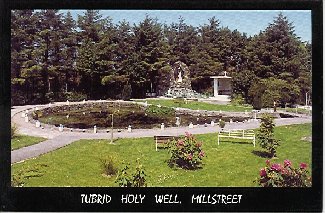
ORIGIN & HISTORY
In the month of May each year vast numbers of people young and old travel to the holy well of Tubrid near the town of Millstreet to “do the rounds”. Their pagan ancestors came to worship the waters of that same well two thousand years ago. People come now to pray the rosary and drink the healing waters.
There have been holy wells and sacred streams in every country in the world where there are so many of these holy wells (as in Ireland) or where they are still so much reverenced by the people. So to have any understanding of the history of Tubrid it is necessary that we have some knowledge of the origin and the motives of the religious reverence which is still due to the holy wells of Ireland.
PAGAN WORSHIP
That the Pagan Irish worshipped the elements there is no doubt. Water, air, fire, were all objects of veneration and in the old books the worship of wells as gods was often mentioned.
The pagan priests in Ireland were known as druids. The druids had the reputation of being great magicians. The most general Irish work for sorcery, magic or necromancy is draiocht, which simply means druidism, a word still in use. Perhaps the most dreaded of all the necromantic powers attributed to the druids was that of producing madness. There is a valley in West Kerry called Glanagalt, the glen of the lunatics, and it is believed that all lunatics if left to themselves would find their way to it no matter from what part of Ireland. When they had lived in its solitude for a time, drinking of the water of Tobarnagalt (the lunatic well) the poor wanderers got restored to sanity. A well in Donegal is reputed to have the same healing powers as Tobarnagalt, and these wells date back to pre-Christian Ireland. It is interesting to note that the Druids had also a heathen baptism. It is recorded that when Ailill Olum, King of Munster in the beginning of the third century was a child “he was baptised pagan fashion in druidic streams”. The ancient Welsh had also a pagan baptism, possibly this baptism was adopted by the druids in imitation of the Christian rite by way of opposition to the new doctrines, devoting the child to the service of their own gods which in the eyes of the Christian was equivalent to devoting him to the devil. The important factor here is that these baptisms took place in druidic wells and streams – places sacred to the pagan Irish.
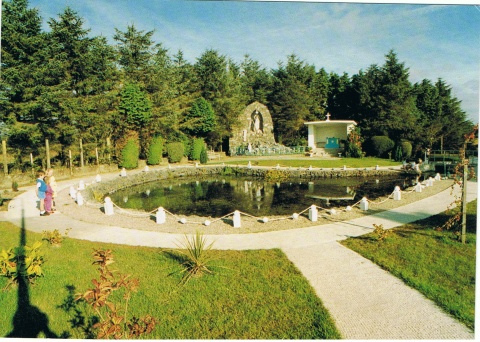
CHRISTIAN WORSHIP
With the coming of Christianity many of the pagan wells were blessed and consecrated to Christian use by the early saints of Ireland.
When Saint Patrick himself came to preach the Gospel in Ireland there were no churches or no baptistry fonts and on his missionary journeys he found it necessary to act as the deacon Saint Philip did with the Eunuch from Euthopia, and baptize his converts in the wayside wells and streams. But the well must first be blessed, for it might have been profaned by evil influences or it might have been a stream which the Druids held sacred to their gods. It was then all the more necessary to bless it by exorcism and prayer and invocation of the Holy Spirit of God: for the Church nearly always thus blesses whatever is to be used for the purposes of Devine worship. The well blessed by Saint Patrick and used by him as a baptistry became a holy spring, and there was a virtue in its water derived from the prayers of the church.
When Colmcille was in Scotland he heard of a fountain famous amongst the heathen people there, which “foolish men blinded by the devil, worshipped as a divinity”. The pagans paid divine honour to the fountain. After Colmcille had rescued it from paganism he blessed it so that it was ever after revered as a holy well that healed many diseases.
In this manner hundreds of the pagan wells were taken over by Christianity and sanctified by the early saints, so that they became more venerated by the Christians than they had been by the pagans.
Yet the pagan practices never quite died out but have continued to be mixed up with Christian devotions even down to our own day, though now devoid of their original pagan spirit and quite harmless. The most conspicuous of the existing practices are offerings of various kinds – rags, pins cups, medals, coins, etc. and which may now be seen at many holy wells. This practice prevail s still in many parts of Europe and even in Persia.
However, it is false to imagine that pilgrims to holy wells doing rounds are simply carrying on the old pagan tradition. Nor is the veneration of these holy wells a superstition. It is well to remember that prayers to the saints, in any spot hallowed by their abode, their r=miracles or their labours, are all the more likely to be erricacious and rewarded.
The blessing of pagan wells and the consecrating of them to Christian use was not the only way in which holy wells originated in Ireland.
There was yet another cause that sanctified many holy wells in Ireland. In the century, especially that succeeded the death of Saint Patrick, the Irish saints loved to seek out some desert spot altogether cut off from the habitations of men, where they might give themselves up exclusively to the service of God. Their food was a little corn, with roots and water from a spring. Hence wherever the hermit lived he always had his cell near some fountain, and that fountain was blessed by his prayers, and doubly blessed by his use – and so it became to be regarded as a holy well.
Sometimes too, it would happed that in their journey through the country the missionary saint like Bridget, Patrick, and Columkille tired and foot-sore, sat down like our Saviour at the well of Samarai to refresh themselves at some wayside fountain. They blessed the grateful stream, and that blessing was long remembered by the people who came from all the country round to drink of its water – and perpetuate its memory as a holy well. In this way we have Patrickswell, Brideswell or Columkilles well or indeed Tobar Ide, Ita’s well.
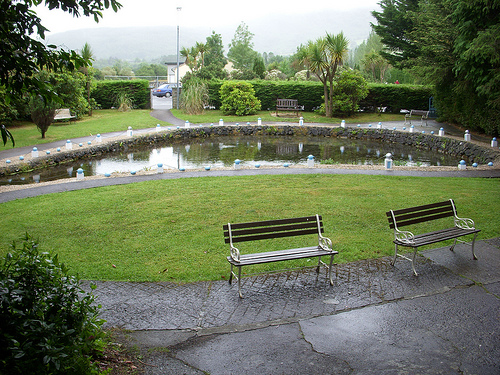
TRADITIONAL ROUND
The traditonal round dates back into the dimness of history. It consists of three visits to the well any Thursday, Friday or Saturday of May. Say a Rosary each day beginning at the Grotto and continue circling the well. Break the Rosary three times at the Grotto to ask Our Lady for request. Finish with six paters, Aves and Glorias. The ceremony ends in the drinking of water from the well. Receive Holy Communion following Sunday. If visiting only one day – say the fifteen decades on that visit, the sex paters etc. and receive Holy Communion on Sunday.
In doing the Rounds the people always turn sun-wise, that is from left to right. This custom is very ancient and like many others has descended from pagan to Christian times. Even to this day some Irish people when burying their dead walk at least once round the graveyard sun-wise with the coffin.
After Patrick has been presented with the site of his future Cathedral at Armagh the saint solemnly consecrated the whole place to the service of God by walking sun-wise round the site holding the Crozier in his hand.
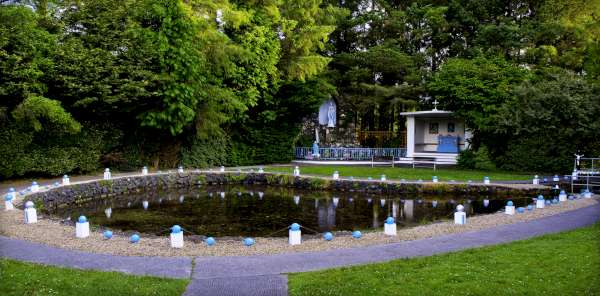
A century later St Senan consecrated Scattery Island on the Shannon in like manner walking sun-wise round it. So it would appear that the pilgrims walking sun-wise round the well at Tubrid are taking a step in the right direction!
According to local tradition a fish appears in the well on ollcasions. The pilgrim who is lucky enough to catch a glimpse of the fish is sure of having his or her request granted!
In the Tripartite Life of St Patrick we are told regarding the well of Aghagower in Mayo, that “Patrick left two salmon alive in the well. The fish were supposed to be immune from death and this immunity was the fruit of St Patrick’s blessing. There are many stories of fish living forever in holy wells. It is interesting to note that the fish especially in the early days of the Church was a Christian symbol of very sacred significance. The name Ichtus which is the Greek word for fish, and the fish itself, are of constant recurrence amongst the sacred symbols of the early Christians in the Catacombs of Rome.
HEALING WATERS
What is it that draws people to Tubrid Well year after year? We know that the element of water was specially sanctified by the spirit of God “Who moved over the face of the water”. Not only amongst the Jews but even among pagan nations the living stream was regarded as the most fitting symbol of spiritual life and indeed we may go further and state that many holy wells have the reputation of curing diseases – one for blindness, another for headache, another for rheumatism and so on through a great number of ailments.
We are all aware of the existence of holy wells and holy streams in Palestine. We are reminded of the Sacred pool at Bethsaida where the sick and the blind and the lame remained in wait for the moving waters.
The Jordan river heard the voice of God when the waters separated to let the Israelites in to the Promised Land. When the Leper – Naiman “went down and washed in the Jordan seven times according to the word of the Man of God his flesh was restored like the flesh of a little child and he was made clean”.
But more than all was the Jordan Sanctified when Jesus stood in the stream and John the Baptist poured on his Head the baptismal waters that were sanctified forever because of contact with His Sacred Flesh.
Jacob’s Well in Samarai where Jesus asked to drink of water from the Samaritan Woman also became a Holy Well.
God brings life out of the waters and men are saved by the waters – for in baptism each one of us has passed through the waters to a new life.
At Tubrid, according to their faith and if it be the will of God for them people are cured by the holy waters of the well. A cripple leaves here crutch there for all to see and walks away. A girl has her hair restored by washing in the well, an eight-year old child begins to talk, a woman has her finger straightened, and American gets relief from arthritis, a priest has a speech-impediment cured. An invalid thirty years in bed gets up and walks again after she has donated the stones for the building of the Grotto.
Such is the story of the well. Such is the faith of the people who come to the well. Such is the providential role of Mary, standing sentinel over the healing waters, drawing the people to herself so that she may guide them to the unfathomable riches of Our Lords life, as seem through her eyes, and unfolded to them in the Mysteries of the Rosary.
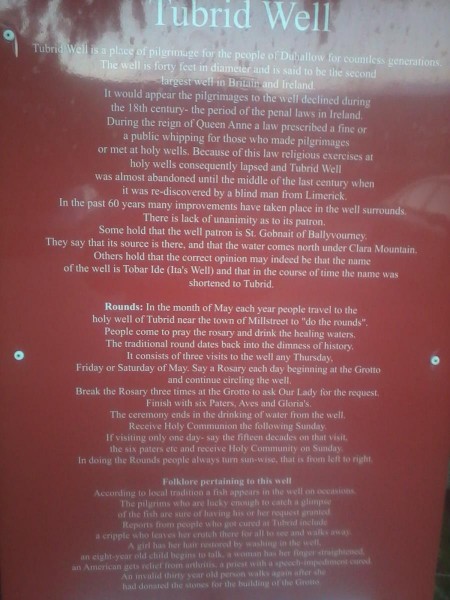
Below is a transcription of the sign (pictured above) which is at the entrance to the grotto and explains the well, its history and folklore
Tubrid Well is a place of pilgrimage for the people of Duhallow for countless generations. The well is forty feet in diameter and is said to be the second largest well in Britain and Ireland. It would appear the pilgrimages to the well declined during the 18th century – the period of the penal laws in Ireland. During the reign of Queen Anne a law prescribed a fine or a public whipping for those who made pilgrimages or met at holy wells. Because of this law religious exercises at holy wells consequently lapsed and Tubrid Well was almost abandoned until the middle of the last century when it was re-discovered by a blind man from Limerick.
In the past 60 years many improvements have taken place in the well surrounds.
There is a lack of unanimity as to its patron. Some hold that the well patron is St. Gobnait of Ballyvourney. They say that its source is there, and that the water comes north under Clara Mountain. Others hold that the correct opinion may indeed be that the name of the well is Tobar Ide (Ita’s Well) and that in the course of time the name was shortened to Tubrid.
Rounds: In the month of May each year people travel to the holy well of Tubrid near the town of Millstreet to “do the rounds”. People come to pray the rosary and drink the healing waters. The traditional round dates back into the dimness of history. It consists of three visits to the well any Thursday, Friday or Saturday of May. Say a Rosary each day beginning at the Grotto and continue circling the well. Break the Rosary three times at the Grotto to ask Our Lady for the request. Finish with six Paters, Aves and Gloria’s. The ceremony ends in the drinking of water from the well. Receive Holy Communion the following Sunday.
If visiting only one day – say the fifteen decades on that visit, the six paters etc and recieve Holy Communion on Sunday. In doing the Rounds people always turn sun-wise that is from left to right.
Folklore Pertaining to this Well: According to local traditions a fish appears in the well on occasions. The pilgrims who are lucky enough to catch a glimpse of the fish are sure of having his or her request granted. Reports from people who got cured at Tubrid include a cripple who leaves her crutch there for all to see and walks away. A girl has her hair restored by washing in the well, an eight year old child begins to talk, a woman has her finger straightened, an American gets relief from arthritis, a priest with a speech impediment cured, an invalid thirty year old person walks again after she had donated the stones for building of the Grotto.
===================
Fr Paddy Byrne told the story on the Feast of the Immaculate Conception 2016 that in the 1930s/40s, Canon Griffin used to walk back the Killarney Road with his greyhound every day, and down to Tubrid to say his prayers. There was no road then, just a path through cutaway bog, nor was there a grotto or rosary, just a spring with a fence around it to keep out the sheep and cattle, and a little gate to go in and out. On seeing the people that were cured in Lourdes, and realising that few in Millstreet would ever get to Lourdes, he set about developing Tubrid, building the grotto, and more, so we had our own little Lourdes in Millstreet.
=======
This interesting piece was a part of a project on holy wells in Cork was published by UCC in 2018:
Tubrid, Millstreet
“It was Fr Griffin who claimed he was cured, he had a stutter. That was the beginning of the real development of Tubrid well. “
Tubrid Well is located on the western edge of Millstreet in north-west Cork: it lies north of the Killarney Road and is adjacent to the River Finnow. It is a developed local pilgrimage site with considerable individual and communal devotion practised. The annual May mass holds a particular significance for the Catholic community of the area. It serves as an opportunity for shared outdoor worship.
“I surmise that Tubrid, which is the most popular well [in Millstreet Parish], is of modern origin. And, the reason for that is it doesn’t feature in the 1840 Ordinance Survey, which you would expect, if it was a holy well at that stage, it would feature…it dates back to the beginning to the twentieth century anyway. According to the folklore, it’s associated with a miracle prior to that in the McCarthy-O’Leary era.”
“It was a priest who used to walk down there, Fr Griffin, that had a stutter, he would drink the water…he was cured. It was tough to get down there from the Killarney road,…Fr Griffin, then, went around the town, he got the donations from people; and, then they brought in the rock and they put in the statue and trees, and there’s a place to say mass; but that all took a long time. “
“The second tradition then is about the McCarthy-O’Leary. They were at some feast in Limerick – wasn’t it?– and this blind man was there, and he had a dream about some place where there was water that would cure his blindness. So he arrived there, and washed his eyes. The well appeared, or he dug the ground; there was water there, and he washed his eyes and his blindness was cured. “
=======
Getting there:
Tubrid Well is about a mile west of Millstreet, about 400m down a lane off the Millstreet-Killarney road (see the map below). It is open year round. There is no entry fee, but there is a donation box for the upkeep of the well.
====
“Holy Wells – in the parish of Millstreet, County Cork there is a holy well. People visit the well still.
A lot of people were cured there. There was a woman of the name of Margaret Leary, and she was a patient in Millstreet Hospital, and she had a crutch. One day she went to the well, and when she was kneeling down a fish appeared in the well, and when she stood up, her leg was cured. She left the crutch at the well.
Another story says, that the people used to use the well water and one morning a fish was seen inside in a kettle…”
— by Michael Lucey of O’Brien Street Cork (1937), from the Dúchas Collection
====
Photos and More
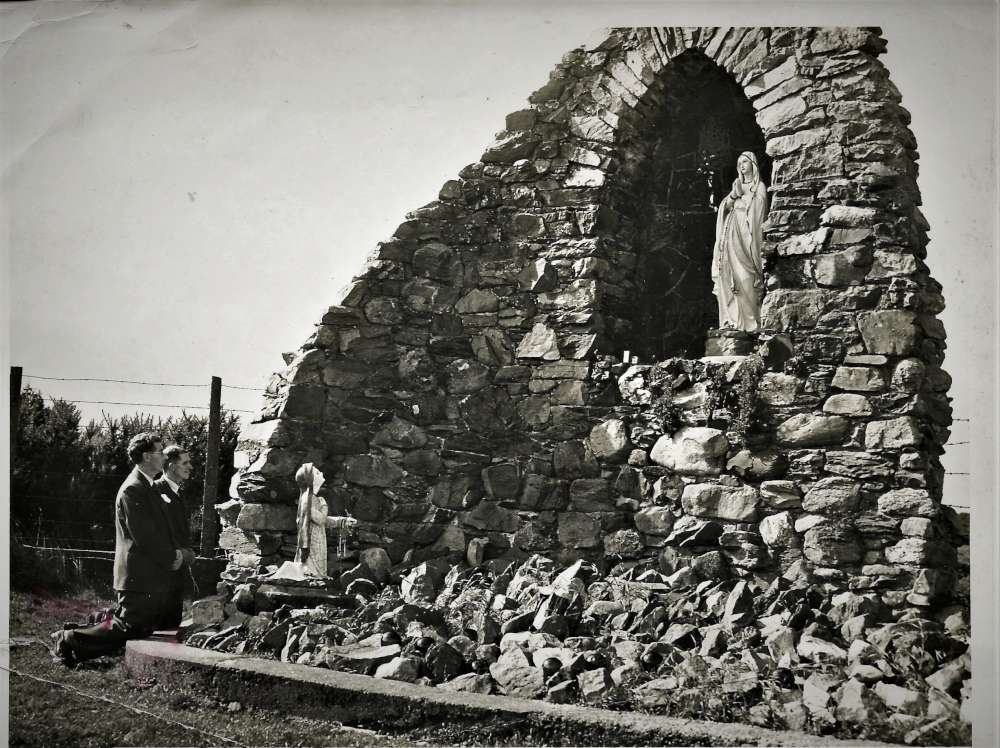

What a lovely place
Thanks for posting this interesting and informative article. I have been here several times, a very peaceful and place to visit, and reflect.
Very tranquil/beautiful and peaceful lovely to reflect and believe in beauty and spirituality in people and the world while looking for these things… very informative site also – thank you!
Doing a project on it 🙂
The water from this well helped my sister immeasurably, it’s a very tranquil and holy place. Congratulations to all who look after it, it’s always well maintained.
Can anyone tell me the meaning of the name Tubrid in old Irish? Is there a connection with Bride or Brigit?
Is it not “Tobair Íde”. Translated to “Ida’s well”, or “Ida’s Spring”. i’d be happily corrected though if that’s not right.
Oh that’s interesting. Who was Ida?
I brought my sister to the well when visiting from Scotland, we came every day. She is disabled and suffered from chronic back pain. Since drinking the water from the well her back pain is gone. Thanks be to god! I always visit when I am in Ireland and bring some water home for her. It’s a truly wonderful place.
Hi Michael, Do you have a reference for the Tobair Íde contraction? With Brid being the original Goddess I can see how Tobair Brid would be contracted to TuBrid and then Christianized to honour St Bride. I have found the following on Catholic.org that mentions an Irish saint by the name of Ita but I am not aware of any connection of St Ita to the Well/Spring or local area. She is reputed to be a niece of St Bride but after founding a nunnery in Killeedy she stayed there until her death in 570 (Search on Íte of Killeedy in Wikipedia for some really good background).
“Ita was reputedly of royal lineage. She was born at Decies, Waterford, Ireland, refused to be married, and secured her father’s permission to live a virginal life. She moved to Killeedy, Limerick, and founded a community of women dedicated to God. She also founded a school for boys, and one of her pupils was St. Brendan. Many extravagant miracles were attributed to her (in one of them she is reputed to have reunited the head and body of a man who had been beheaded; in another she lived entirely on food from heaven), and she is widely venerated in Ireland. She is also known as Deirdre and Mida.”
Paul
hi Paul,
There’s a sign at the entrance to the well which briefly explains the well, it’s history and folklore, I’ve added a photo of the sign above and added the transcribed text beside it. Below is what it says of the name:
There is a lack of unanimity as to its patron. Some hold that the well patron is St. Gobnait of Ballyvourney. They say that its source is there, and that the water comes north under Clara Mountain. Others hold that the correct opinion may indeed be that the name of the well is Tobar Ide (Ita’s Well) and that in the course of time the name was shortened to Tubrid.
So noone knows for sure where the name comes from … but they don’t mention Bríd in the name.
As for the link to St.Ita locally, there is mention of the earliest known church in the parish dating from the 14th century two miles south of Millstreet at Kilmeedy dedicated to St.Ita (Cill mo Ide) [from page 11 of “The origin and development of the Parish of Millstreet” by Fr Seán Tucker http://aubanehistoricalsociety.org/aubane_collection/parish.pdf ]
But I suppose if we don’t know now, we’ll never know for certain
hope that helps
I’m just glad it’s there. What a beautiful tranquil place for prayer and contemplation.
Thank you for the link to the Aubane Historical Society and Fr Tucker’s research. I love local history and so much of it remains waiting to be rediscovered.
Paul
thanks to RITCHIE and MARY. What a brilliant piece??????
Tubrid well is a beautiful place for Our Lady, its a serene place to pray for all intentions, and a big thank you to all the people who keep it beautiful
When is the next mass held
Great article. Would dispute the biggest well I Ireland however… at Bernard’s Kyle well in Glen if Aherlow strikes me as bigger